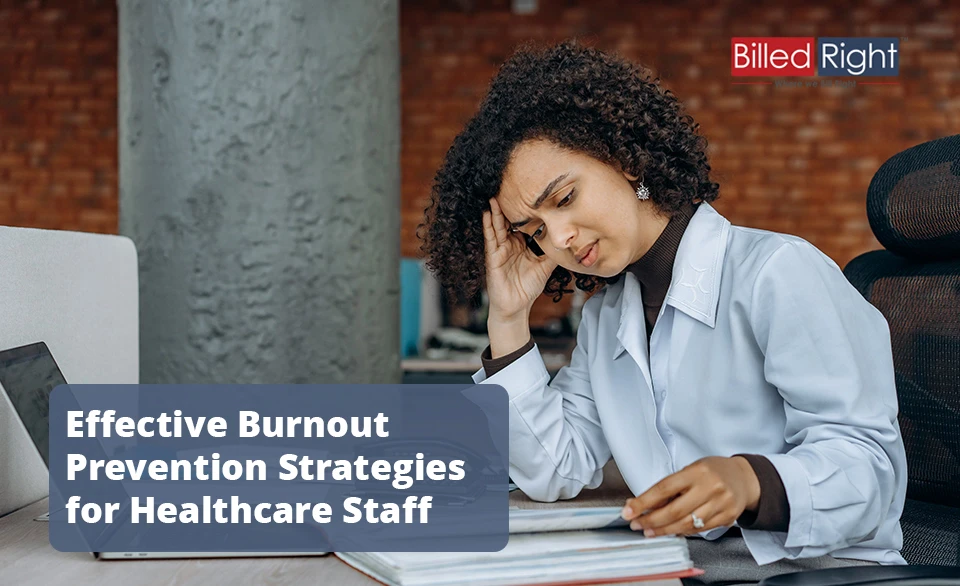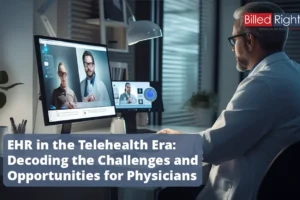Effective Burnout Prevention Strategies for Healthcare

Introduction
Welcome to our blog series addressing healthcare burnout. At Billed Right, we understand the importance of managing healthcare burnout and its impact on healthcare providers and patients alike. As trusted advisors and strategic partners in healthcare workflow and management, we are dedicated to providing valuable insights and solutions to support healthcare professionals in managing burnout effectively. Join us in this series as we delve into the causes and consequences of burnout and explore practical strategies to help healthcare providers mitigate the effects of this pervasive issue.
The World Health Organization (WHO) defines burnout as a “syndrome conceptualized as resulting from chronic workplace stress that has not been successfully managed”.
To prevent and manage healthcare burnout, it’s important to recognize the signs and symptoms, develop coping strategies, and prioritize self-care. In the first installment of the blog series covering the theme of burnout, we would like to explore some of the more effective strategies being used all across the country to prevent burnout in the healthcare industry. Specifically, we will look at the importance of creating strong team dynamics with your peers, successful strategies for managing workloads within your practice, and the importance of feedback and recognition. We hope that by implementing these strategies, healthcare organizations like yours can create a healthier, more supportive work environment that helps in the approach to help prevent burnout and promote better outcomes for both staff and patients.
I. Team Building
Activities to promote team building
Strong team dynamics within your practice are of utmost importance when focusing on providing quality patient care and reducing the possibility of burnout among the healthcare professionals in your vicinity. Doctors and practice managers can promote team building in various ways, such as:
Team-Building Workshops: Attending team-building workshops that focus on activities such as communication, conflict resolution, and problem-solving is sure way to lay the groundwork on what team building is really about. These workshops help team members learn how to work effectively together and build trust.
Holding Regular Team Meetings: Finding the time to come together with your team should be a significant goal of yours while running your practice. In these meetings, your staff should be able to find a comfortable space where they can openly discuss their roles, responsibilities, and challenges within their day to day functions. By doing so, your staff will feel heard and you will also be able to identify any processes in your practice that can be optimized to improve your practices efficiency.
Celebrations and Recognition: This is one that we at Billed Right as an organization value very much. Celebrating team successes and milestones with recognition ceremonies, social events, or team-building activities is a great way to acknowledge and reward team members for the hard work they have achieved. Taking these actions can prevent burnout by boosting morale, motivation, and a sense of shared accomplishment among the team.
Benefits of team building for burnout prevention
Team building within your organization can have a surplus of benefits for preventing burnout among healthcare professionals. These advantages include:
- Improved communication and teamwork among healthcare staff
- Enhanced job satisfaction and motivation
- Reduced stress levels and burnout symptoms
- Enhanced patient care and outcomes
By promoting team building, doctors and practice managers can create a work environment that is supportive, collaborative, and positive, which can help to prevent burnout among healthcare professionals.
II. Workload Management
Healthcare professionals like you and your colleagues often encounter an overwhelming amount of workload, which can contribute to burnout. To put it into perspective, excessive workload is one of the most common causes of burnout among healthcare workers. That’s why effective workload management strategies are essential for preventing workplace burnout.
Common causes of excessive workload
Several factors can contribute to healthcare workers having an excessive workload. These can include inadequate staff numbers, extraordinarily long workdays, challenging administrative tasks, and a lack of supplies or support. Overworked healthcare professionals struggle to maintain work-life balance, leading to burnout.
Strategies for Managing Workload
Healthcare practices must put in place efficient workload management techniques to avoid burnout. Some critical strategies include:
- Task prioritization: Healthcare professionals should be motivated to arrange their your tasks according to importance and urgency. Doing this, you will be to manage their workload more effectively and prevent feeling overburdened as a result of this.
- Task delegation: When necessary, healthcare professionals should empowered to assign tasks to other team members. This can aid in maintaining concentration on your primary duties and preventing burnout.
- Establishing manageable schedules: Healthcare organizations should work to establish staff-friendly schedules that are reasonable and feasible. To ensure that everyone has a manageable workload, this may entail modifying staffing levels or rearranging workloads.
- Provide Training and support: To help staff manage their workload more skillfully, healthcare organizations should train and support them. This could involve learning stress-reduction strategies, time management skills, and how to access resources for support.
Implementing Burnout Prevention Strategies in the Workplace
Implementing successful strategies for preventing burnout in healthcare is essential to maintain the well-being of healthcare professionals and the patients they serve. Here are some steps that healthcare organizations like yours can take to implement effective burnout prevention strategies in the workplace:
How to put excellent strategies into practice
- Assess the Existing Situation: It is essential to assess the current work environment before implementing any burnout prevention techniques. This can be accomplished by asking healthcare workers about their present workload, team relationships, and feedback and recognition methods using surveys.
- Develop a Plan: Based on the findings of the evaluation, healthcare institutions can develop a plan that specifically tackles the areas of concern. The plan should clearly define the goals, next steps, and due dates.
- Communicate the Plan: After the plan has been developed, it is crucial to ensure all healthcare professionals are aware of the plan once developed. Staff meetings, emails, or training sessions, are ways in which you can accomplish this.
- Train and Educate: It’s critical to train and educate healthcare workers on tactics alongside the plan. Training on efficient team building, workload management, and techniques for feedback and appreciation can be included in this.
- Track Progress: It’s crucial to track progress when the strategies are implemented and to adjust as necessary. Regular check-ins with health personnel, monitoring key performance metrics, and assessing feedback can all help with this.
Overcoming Potential Obstacles
Implementing burnout prevention strategies in healthcare organizations may face several obstacles. One of the primary obstacles is resistance to change. Healthcare professionals in your practice may be resistant to new strategies or changes to existing practices. Therefore, it is vital to involve them in the planning process and communicate the benefits of the new strategies. Providing access to education and training can also help them overcome resistance to change.
Lack of resources, like time and funding, can hinder effective strategy implementation.
If you feel burnout can become a prevalent issue in your practice, you should place a focus on prioritizing burnout prevention and reallocating organization resources as needed.
Measuring the Effectiveness of Burnout Prevention Strategies
It is crucial to measure the effectiveness of burnout prevention strategies to ensure that they have the desired impact. Healthcare organizations can use several metrics to measure effectiveness, including employee satisfaction and engagement, turnover rates, patient satisfaction, and quality of care. You can also conduct regular assessments or surveys to gather feedback from both healthcare professionals and patients.
Conclusion
Implementing these strategies is crucial for the well-being of healthcare professionals and the patients they serve. Burnout can have negative effects on both the individual healthcare professional and the quality of care they provide. Therefore, it is important for healthcare organizations to prioritize burnout prevention and invest in strategies to support their staff.
Healthcare organizations have a responsibility to prioritize burnout prevention and support the well-being of their healthcare professionals. This includes providing resources, training, and support for strategies such as team building, workload management, feedback, and recognition. By taking action to prevent burnout, healthcare organizations can create a healthier and more supportive work environment for their staff and improve the quality of care for their patients.







